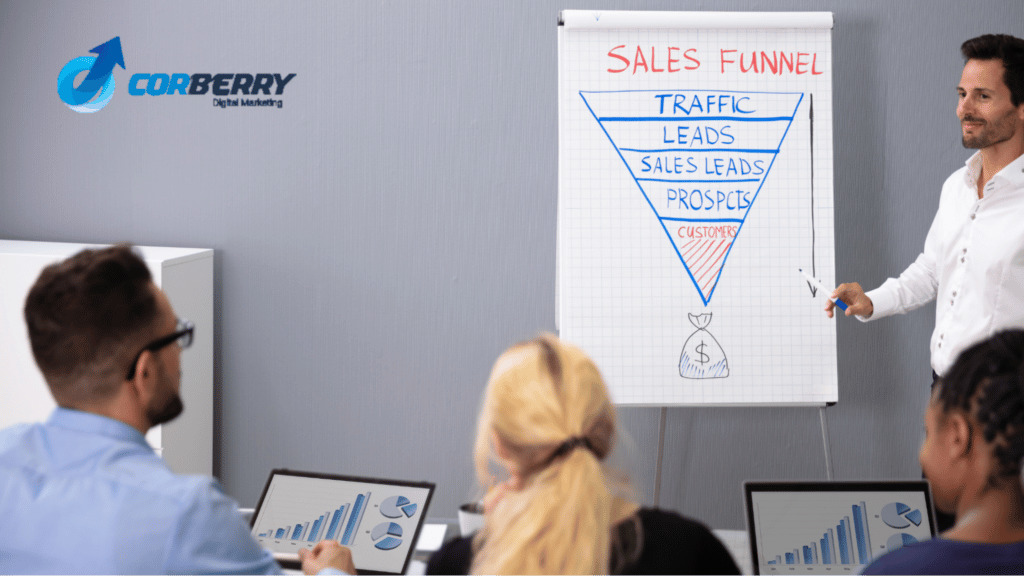
When it comes to making and selling a product, getting clients, or even adding new traffic, having a digital marketing funnel is pivotal. When it comes to marketing a product, making sure there is a proper buyer journey and that all the products are marketed while keeping in mind the consumer’s behavior is vital.
For the most part, a marketing funnel can be used across businesses, and while an additional marketing funnel is specific to more digital channels, like PPC, blogs websites, and applications it follows the same rules as any traditional marketing funnel.
Ever since its conception, the marketing funnel has seen many iterations and, since the existence of the digital marketing funnel, there have been modern modifications made and several versions that are standard to different models of business models.
So, while your fundamentals may be on point, it would be a good idea for you to be better acquainted with the modern take on digital marketing strategy and the modern digital marketing funnel to better understand the buyer’s journey.
What Is a Digital Marketing Funnel?
A digital marketing funnel is a sales funnel designed to drive consumers and conversions via a website, page, or application. So, when it comes to a digital marketing funnel, there are five stages: awareness, interest, decision, action, and re-engagement. However, this has also been replaced with the modern digital marketing funnel.
What Is the Modern Digital Marketing Funnel?
Traditionally, there are five stages of the digital sales funnel: awareness, interest, decision, action, and re-engagement. The modern digital marketing funnel has 10 stages, which are engagement, education, research, evaluation, justification, purchase, adoption, retention, expansion, and advocacy. These stages do a much better job of capturing the consumer’s digital buying journey online when compared to the original model.
5 Stages of the Old Digital Marketing Funnel
1. Awareness
The first and basic requirement of any sale is gaining consumer awareness. It is one of the most important phases of improving product awareness and can be done in a multitude of ways.
On a website, it’s done through visibility on SERP, and, in the case of Amazon sellers, it’s done through product placement on websites and visibility through search results.
There may be several different methods to gain awareness for your brand, like ranking on Google, display advertisements, Facebook Ads, and social media. For the most part, it comes down to what product and demographic you wish to market to.
2. Interest and Evaluation
When it comes to the interest and evaluation of the product, it depends on the consumer’s needs and requirements. With digital marketing funnels, it’s vital that you market your product to a market segment that has a need for it.
That said, there are several factors that come into play here, like the use of convincing copy and displays, branding colors, and even the product design. From a marketing perspective, it’s important that the company highlights the key features and unique selling points the product has.
But at the end of the day, it can come down to price and whether the product is within the consumer’s price range for it to have higher demand.
3. Desire
When it comes to desire, it boils down to the need and requirement for the product. Generally, convincing someone about the utility and usefulness of the product can help with conversions and sales.
For marketing experts, making sure to entice this through copy and highlighting features is the primary objective. Doing this through various visuals to market the product on various platforms is an aspect that is well-planned and thought out.
4. Action
This stage of the marketing funnel is most vital and leads to revenue or potential conversion and revenue through action. The conversion or objective that takes place depends on what the goal of your funnel is. This can be driving traffic, generating leads, or just direct sales.
However, your marketing funnel can be for various different goals related to your digital marketing needs. With this, you should remember that there can be a desire for a product that does not translate to action.
5. Re-Engagement
Unlike the traditional marketing funnel, this stage of re-engagement is after the sale of the product. After the sale, in digital marketing, products, and related products are recommended to the user. This remarketing process can be in the form of emails, push notifications, social media retargeting, or any other means.
Related Article: Top 7 Benefits of Digital Marketing Services that You Should Know
10 Stages of the Modern Digital Marketing Funnel

The modern digital marketing funnel has over 10 different stages. While traditionally there are 5 stages, this model illustrates the buyer’s journey in great detail and also helps marketers better understand consumer behavior so they can market the product accordingly.
1. Engagement
The engagement stage is where the product and the brand are introduced. It is at this stage that brand awareness is formed. Generally speaking, this phase is where marketing is done on multiple platforms. Also, it’s important to ensure there are multiple touch points to ensure the consumer acknowledges the brand and has a positive experience related to it.
2. Education
For the most part, most consumers are not fully aware of the problems that exist. In the education stage, various issues and problems are brought to light. Besides this, issues caused by the problem are also highlighted. This can be through conveying facts or statistics, or communicating issues that happen in day-to-day life.
3. Research
During the research phase, the consumer looks for solutions and researches various ways in which their problem can be solved. When doing this, they also look for the benefits of solving the problem and the various solutions there are to solving the problem. In this stage, various options are looked at and awareness of the product or service takes place.
4. Evaluation
During the evaluation stage, the product is assessed and there is an analysis of its capability, specifications, features, and even how it works. Generally speaking, you just look for reasons to buy the product based on your needs on multiple levels. This can include your income segment, demographic, or personal preferences. The evaluation process is subjective and depends entirely on the consumer’s personality.
5. Justification
When it comes to justification for buying the product, it is down to the brand’s value and social demand than the endorsement of the product itself. Different types of consumers, have at times different motivations and justifications to buy the product. With justification, some of it can come from within their social circles or the consumer’s peers. But, it can also come from external sources, like influencers and promoters.
6. Purchase
This is a stage where action takes place, where the purchase or buying of the product is made. While, in the traditional marketing funnel, this is the final stage. In the digital marketing funnel, this is one of the main goals (but not the last).
7. Adoption
This is the stage where the consumer gets to use the product hands-on and also try it out or check it in different ways and methods. It’s in this stage that the consumer gets used to the product and understands its utility. In adoption of the product, the consumer is likely to repurchase it or continue to use the product for a continuous period of time.
8. Retention
The retention phase of the product is where the consumer decides whether they’re happy with the product and if it meets all their needs and requirements. The retention phase helps consumers come to see the brand as authentic and one set on solving problems.
9. Expansion
During this stage, consumers are open to purchasing and buying additional products from the same brand. In the expansion stage, it’s relatively easy to cross-sell and upsell products. Generally speaking, when consumers see your brand as trustworthy and communication becomes a lot easier.
10. Advocacy
This is the final stage of the modern digital marketing funnel. In this stage, the customer’s trust is established and the customer themselves become a brand ambassador marketing the product. The advocacy phase allows for consumers to provide value through referrals and brand loyalty helps to ensure an impressive ROI.
Benefits of the Modern Digital Marketing Funnel
Setting Goals and Targets to Meet
Marketing funnels ensure that there are clean-cut goals set for the marketing team and the sales funnel as a whole. Digital marketing funnels help marketers set realistic expectations, goals, and targets to be achieved through well-planned and thought-out marketing campaigns.
Measuring Brand Growth and Impact
When it comes to brand growth, the progression of the brand’s popularity and image through the set stages of the modern digital marketing funnel is something to pay attention to. Through the progression of the marketing funnel, you can get a fair idea of your current audience, as well as your growth and impact as a brand.
Mirrors the User’s Buying Experience More Accurately
Unlike the traditional and old-school digital marketing funnel. The modern digital marketing funnel does a great job of mirroring the actual buyer’s journey and the impressions the brand makes accordingly.
While this may not seem significant, from a marketing perspective, it helps brands establish guidelines and targets to achieve. Unlike the traditional marketing funnel, the modern marketing funnel takes into account the consumer’s interaction with the brand post purchase.
Frequently Asked Questions
What is brand awareness?
Brand awareness is the idea of consumers being aware of the brand and the product. For new products and brands entering the market gaining traction and brand awareness can be tricky with many options available.
What is re-engagement?
Re-engagement is a phase of the older digital marketing product funnel, where the client has upsold or cross-sold additional products or has marketed to ensure the promotion of the same.


